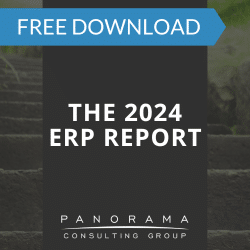ERP system integration is critical for creating a seamless data ecosystem within an organization. This integration involves linking and synchronizing an ERP system with other software applications across the organization.
However, ERP integration comes with its fair share of challenges, often leading to costly and disruptive issues if not managed correctly.
Today, we will delve into common ERP integration issues, offering insights and real-world examples to guide businesses towards a successful implementation.
A Failed Payroll System Implementation
Panorama’s Expert Witness team was retained to provide a forensic analysis and written report to the court regarding the failed implementation of a major software developer’s ERP/payroll system.
5 Common ERP Integration Challenges
1. Data Migration
Data migration involves transferring data from legacy systems into the ERP system, a process fraught with risks such as data loss, duplication, and corruption.
To mitigate these risks, it’s crucial to establish a robust data validation process. Ensuring data accuracy from the start can prevent cascading errors that complicate later stages of the integration.
To illustrate, if a healthcare provider wants to migrate patient records to a new ERP system, it must first develop a data migration plan to ensure the data is cleansed and standardized. Discrepancies in data formats between the old and new systems may lead to incomplete patient histories and incorrect medication records.
2. System Complexity
When integrating disparate systems, each system may have its own data formats, interfaces, and workflows.
Addressing this complexity involves thorough documentation and understanding of all business processes before initiating integration efforts.
Consider a large manufacturing company with separate systems for inventory management, order processing, and customer relationship management. Each system has developed over time with specific customizations.
Integrating these systems into a single ERP solution would require a detailed understanding of their interactions, dependencies, and data flow mechanisms to avoid disruptions in any single operational area.
3. Continuous User Training and Support
ERP integrations change how users interact with systems. Employee training is essential to ensure that users can adapt to new processes and technology. A lack of comprehensive training can lead to poor system adoption.
For example, after a new ERP system is integrated at a professional services company, the staff may find the new interface confusing, leading to a significant drop in productivity. This situation could be remedied through additional targeted training sessions.
4. Data Security
The integration of various systems can open up new vulnerabilities, particularly through increased points of access.
To prevent security breaches, it’s vital to implement comprehensive security measures, including multi-factor authentication and regular audits of security protocols.
To illustrate, a retail chain integrating its online and brick-and-mortar sales systems into an SCM system might encounter significant security issues. The integration would create multiple points of access, and a hacker could exploit these vulnerabilities to access sensitive customer data.
Implementing stringent security measures, such as multi-factor authentication would help mitigate these risks by adding an additional layer of security, making it more difficult for unauthorized users to gain access to the system.
5. Real-Time Data Access
Modern businesses require real-time data to respond swiftly to operational issues and market changes. Traditional ERP systems, designed around batch processing, may not suffice, especially when it comes to e-commerce tracking and on-demand inventory management.
A manufacturing company we worked with struggled with inventory discrepancies due to its traditional ERP system’s batch processing. To address this, the company implemented a real-time data processing module that directly linked their production lines and inventory management systems.
This integration allowed immediate updates to inventory levels whenever materials were used or products were completed. The result was a significant reduction in inventory errors, improved production efficiency, and enhanced ability to respond swiftly to customer demands and supply chain issues.
Best Practices for Successful ERP Integration
1. Prioritize Detailed Planning
Start with a comprehensive assessment of all current systems and business processes. This step is crucial to understanding integration points and potential data flow disruptions.
2. Engage Expert Consultants
Given the complexities involved, enlisting ERP consultants with a track record of successful integrations can provide valuable insights and steer the project towards success.
3. Implement Incremental Changes
Rather than overhauling systems all at once, adopt an incremental approach to integration. This strategy allows for addressing issues as they arise and adjusting the integration process based on real-time feedback.
4. Focus on Change Management
Effective organizational change management ensures that all stakeholders are on board and adequately prepared for changes. This includes ongoing support and training, as well as proactive communication about the benefits and changes brought by the ERP integration.
Consequences of Ignoring ERP Integration Issues
Ignoring ERP integration issues can lead to significant setbacks, including ERP failure, which can have devastating effects on an organization’s business operations. A failure in ERP integration often results in system downtime, process disruptions, and data inaccuracies, which can diminish trust in the system and lead to costly recovery measures.
Consider a scenario where a company fails to integrate its supply chain management system properly with its new ERP. The lack of accurate data synchronization may lead to an overstocking of inventory, tying up capital unnecessarily.
Furthermore, the ERP system might be unable to process orders efficiently, causing delays and customer dissatisfaction. This not only hurts the company’s reputation but also has a direct impact on its revenue.
To avoid such failures, it is crucial to address integration challenges proactively. Understanding the risks and implementing strategic safeguards is essential for a successful ERP integration.
Overcome ERP Integration Issues With Panorama’s Guidance
ERP integration is not without its challenges, but with careful planning, expert advice, and a focus on data integrity and security, your organization can significantly enhance its operational efficiency and data coherence.
If your company is experiencing ERP integration issues, our ERP consultants can help you pave the way for a successful integration that aligns with your strategic goals. Contact us below for a free ERP consultation.














